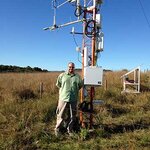Aerospace

Gravitational waves are phenomena predicted by Einstein's theory of General Relativity but no one has ever observed them and their discovery would have profound implications for the study of the Universe.
Last March, the team behind the BICEP2 project made a ground-breaking announcement: the Antarctic observatory had detected a signal referable to gravitational waves. The study said they excluded possible contaminants - other sources that could have generated the same signal - and that the observation was valid.
Enter falsification. To test the observation, the team in charge of analyzing…

America is one giant leap closer to get back as a big-time spacefaring player. NASA's decision on Tuseday, announcing the winners of Commercial Crew Transportation Capability (CCtCap) contracts gave the nation a much awaited proof that launching humans to space from U.S. soil is only a matter of time and America is back on track with only on lap to go, a straight one without any obstacles. Thus, a nationwide reaction was enthusiastic and full of hope, as we listen to politicians, space foundations and societies. "This is a good day for our nation's space program and for all Americans,” said…

For obvious reasons spaceflight has been reserved for governments and the very wealthy. And when it comes to governments, the criteria are stringent. They will get thousands of applications per year and quickly weed out most of them. Predominantly you have to already be a government employee to have any chance of being an astronaut so that is a big disqualification for much of the best and brightest in America.
Today, you don't have to be an astronaut to go into space. Now that it is no longer controlled by the government, technologically has become advanced enough for companies and people…

Objects in space spin, most people know that, but what is less known is that they spin in a way that's totally different from the way they spin on earth.
It comes down to where their centers of mass are, and how their mass is distributed - knowing how things will spin is crucial to any number of actual or potential space missions, from cleaning up debris in the geosynchronous orbit favored by communications satellites to landing a demolition crew on a comet.
In the Journal of Field Robotics, MIT scholars describe a new algorithm for gaging the rotation of objects in zero gravity using only…

The inter-agency commission of the Cosmonauts' Training Center on Friday approved the primary crew lineup for the Soyuz TMA-14M spacecraft.
The crew consists of Roscosmos (Russia's Federal Space Agency) cosmonauts Aleksandr Samokutyayev and Yelena Serova, as well as NASA astronaut Barry Wilmore. The backup crew comprises Russian cosmonauts Gennady Padalka and Mikhail Korniyevko, as well as American astronaut Scott Kelly.
The International Space Station (ISS) crew members told journalists that the current geopolitical situation will not interfere with the joint work of Russian and…

Artistic rendering of Philae on the comet 67P/Churyumov-Gerasimenko. Credit: ESA/ATG, CC BY
By Ian Wright, The Open University
There is much excitement about Rosetta at the moment. The European Space Agency’s spacecraft has already made a successful rendezvous with a comet and the images that are being transmitted back are simply awe-inspiring. There is much more to come – the spacecraft will ride alongside the comet for at least another year.
Meanwhile, as early as November, there will be an attempt to put a lander, nicknamed Philae, on the surface of the comet, continuing the string of…

Let’s say it straight. Mars is, without any doubt our next step in space exploration, sparking our imagination for many years in spaceflight history. After sending tons of scientific rovers, it’s about time to send human pioneers to start colonizing the Red Planet.
The only question is when will we reach that highly anticipated milestone? “Sending humans to Mars around 2033 should be the single organizing principle of future space exploration,” Professor G. Scott Hubbard of Stanford University and former NASA Ames Research Center director told me. He will give a speech on Sept. 6 about Mars…

Tropical Storm Karina was weakening on August 20 when NASA's Terra satellite passed overhead. The Moderate Resolution Imaging Spectroradiometer or MODIS instrument aboard Terra snapped a visible image of Tropical Storm Karina on August 20 at 19:40 UTC (3:40 p.m. EDT). The MODIS image showed that a thick band of strong thunderstorms spiraled into Karina's center from the southeast. The band of thunderstorms wrapped around Karina's eastern and northern quadrants, spiraling into the center from the west, making the tropical cyclone look like the number nine.
That's all well and good but people…

Soil moisture plays a major role in the environment/climate system because the transport of water within the land and at the land-atmosphere interface is strongly dependent on the state of soil water in a region.
Despite its importance, lack of soil moisture measurements at various spatial scales has limited our understanding of how individual physical factors control soil moisture dynamics.
AMUSED (A MUlti-scale Soil moisture-Evapotranspiration Dynamics study) is a project that will monitor soil moisture using cosmic-rays sensors in combination with land surface modeling, satellite remote…

The Venus Express spacecraft just spent a month of aerobraking that saw it surf in and out of the atmosphere of Venus at altitudes typically between 131 km and 135 km for a couple of minutes on each of its closest approaches to the planet. Why? Because after 8 years its propellant is getting low so it was time to do something new while it was still possible.
Before, normal operations involved an elliptical orbit every 24 hours that took Venus Express from 66,000 km over the south pole down to around 250 km at the north pole, just above the top of the atmosphere. The recent aerobraking…